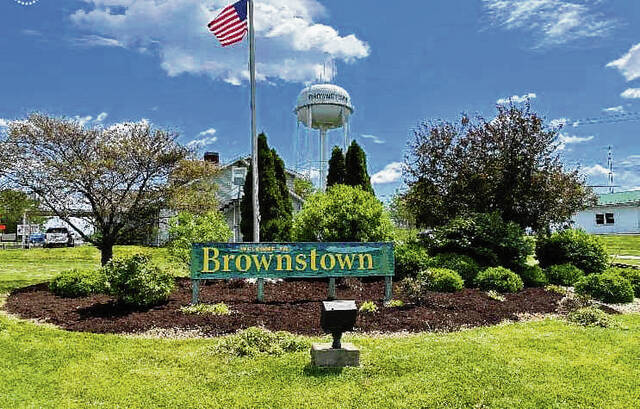
BROWNSTOWN — Individuals and entities working together resulted in Brownstown receiving $700,000 in grant funding.
On Thursday, Indiana Lt. Gov. Suzanne Crouch and the Office of Community and Rural Affairs announced 20 rural Indiana communities will be awarded more than $12.2 million in federal grant funding to create and expand community facilities and improve water infrastructure.
Brownstown is one of 15 communities receiving money from the Wastewater/Drinking Water Program, which has a goal of protecting the health and environment, reducing utility rates for low- to moderate-income communities and improving rural infrastructure to enable long-term economic growth. Eligible projects include many aspects of wastewater improvements and drinking water system improvements.
The town’s funding will address needed upgrades within the sanitary sewer lines and manholes scattered throughout the community and improvements within the wastewater treatment plant and two lift stations.
Scott Hunsucker, superintendent of Brownstown Wastewater Utility, said the town received the full amount available from OCRA, and the local match of 20% will come from the wastewater utilities capital improvement fund.
The project was made possible by the work of Hunsucker, Jeff Lubker, the Brownstown Town Council, Wessler Engineering and grant administrator Shannon McLeod of Priority Project Resources.
“I am extremely grateful that OCRA not only recognized our need for the infrastructure updates and improvements but also our need for funding assistance to make this project even possible,” Hunsucker said.
To apply for the OCRA grant, he said a preliminary engineering report had to first be completed. That identified issues and needs of the wastewater utility with solutions to fix them.
The report then had to be approved by the council, OCRA and Indiana Department of Environmental Management.
Next, Hunsucker said they had to design the project and weigh out all options to come up with the best plan for the wastewater utility to correct the issues.
Once the design was 90% completed, they could then apply to OCRA for a grant for the project.
The sanitary sewer system portion of the project will consist of cured-in-place pipe lining the existing sanitary sewer main and spray lining and structural rehabilitation of sanitary manhole structures that are classified as Priority 1.
“We will be sliplining the sanitary sewers, replacing several 6-inch clay sewers with 8-inch PVC, repairing manholes, then spray lining an epoxy coating to add longevity to them, replacing some that are beyond repair and adding some at the end of dead end lines to allow for sliplining of the sewers,” Hunsucker said.
Storm sewer system rehabilitation will consist of replacement of eight storm structures, rehab of 14 storm structures and drainage studies of seven future project areas within the town.
The total estimated project cost is $2,244,000.
The Vallonia Road lift station improvements will increase the peak capacity to handle anticipated future flows and replace aging and deteriorating equipment to extend the anticipated useful life of the station. The 35-year-old lift station on the southwest side of Brownstown serves 75% of the town and has reached capacity.
The Bob Thomas lift station improvements will convert the station from a dry-pit/wet-pit configuration to a submersible configuration to eliminate existing safety hazards during operation and maintenance. The 40-plus-year-old station is off of U.S. 50 on the north end of town.
For both lift stations, the site layout will be adjusted to allow for improved accessibility for routine maintenance and operation, and electrical improvements will be made to ensure continued operation during power outages and system failures and allow for remote system monitoring.
At the wastewater treatment plant, work will consist of replacing aging or undersized equipment to ensure continued compliance with the discharge permit and miscellaneous site improvements to extend the anticipated useful life of the plant.
Those estimated project costs are $5,274,000.
Hunsucker said the OCRA grant is just one part of the total funding package but is one of two sources that are not required to be paid back.
Once IDEM has finished its review, he said the next step will be to submit the project to the State Revolving Fund to apply for Indiana Finance Authority funds, as they have stimulus funds set aside for forgivable loans. The remaining balance will be funded through SRF loans.
Hunsucker said the project will help he and Lubker in several ways.
“This project will help with the disposable wipe issue we experience (residents flushing them down the toilet), will allow the lift stations to automatically switch to emergency power (no more going out in the middle of a storm during power outages), along with replacing aging infrastructure and updating equipment that parts availability is an issue if parts are available at all and hopefully allow us to televise and clean more sewers,” Hunsucker said.
“These improvements and upgrades should place the utility in a good position to meet the current and future issues and permits for the next several years,” he said.
The state distributes the Community Development Block Grant funds to rural communities, which assist units of local government with various community projects, such as infrastructure improvement, downtown revitalization, public facilities and economic development.
This time around, there also were three communities receiving grants from the Public Facilities Program and one town and one county receiving funding from the Stormwater Improvement Program.
Funding for these programs originates from the U.S. Department of Housing and Urban Development’s CDBG program and is administered for the state by OCRA.
